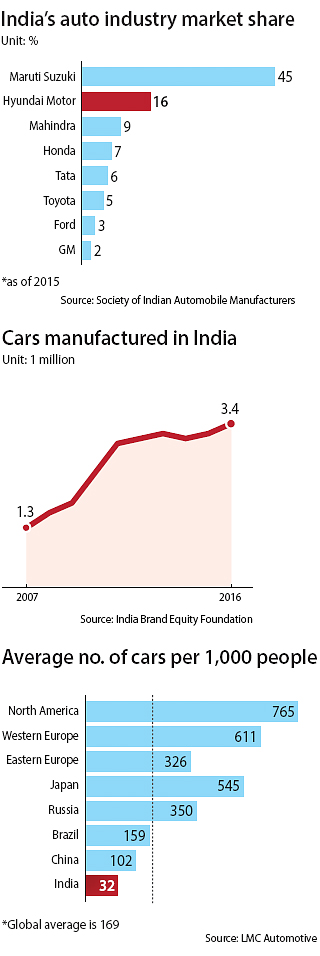Korea firms race to enter Indian auto market

Depressed sales in China due to an apparent diplomatic issue and an unstable relationship with the United States are accelerating domestic companies’ advancement in India.
A total of 294 Korean companies set up shop in India last year, 30 percent of which, or 88 of them, were associated with the automobile industry, according to statistics from the Korea Trade-Investment Promotion Agency,
Hyundai Motor entered the market in 1996 and built a local manufacturing plant in Chennai in 1998 capable of churning out 650,000 cars a year. The company has invested 3.5 trillion won ($3 billion), including that of suppliers, in India so far.
Its sister company Kia Motors is building a factory there worth $1.1 billion. The plant, located in Andhra Pradesh, not far from Hyundai Motor’s Chennai facility, is able to produce 300,000 cars per year. The factory is scheduled to be completed in the latter half of 2019.
Hyundai Steel, an affiliate of Hyundai Motor which makes steel plates for cars, is considering establishing a new steel service center near the soon-to-be-built Kia Motors plant. Plan B for the crucial market is expanding the existing steel service center in Chennai to handle new demands from Kia’s plant.
Auto-parts makers are no exception in the race to India.
Hyundai Mobis is planning to build a module factory in India after recently announcing it would transform its 10-year-old technical center in Hyderabad into a lab dedicated to future-car technology such as self-driving systems.
Hyundai Glovis, a logistics company specialized for the auto industry, also said it is “considering building a consolidation center in India soon.”
India is considered a gold mine for most global automakers and their suppliers. It is a populous country but the number of cars owned per 1,000 people only amounts to 32 while the global average is 169.
The fact that the Indian government allows 100 percent foreign direct investment in its automotive industry without going through a government approval process, also makes the country an attractive destination for many auto firms.
North America holds the highest score, with 765 cars per 1,000 people on average. China’s score is 102.
“Low penetration rate of cars in India means that if the Indian economy surges in the future, its automotive industry will get bigger as well,” said Rakesh Batra, a leader of the automotive sector at Ernst & Young.
“In the next three years, the penetration rate of cars will jump by 1.5 times,” he added.
India’s automotive industry has been expanding for the past couple of years.
Last year, in particular, it surpassed Korea’s in terms of the number of cars produced domestically to become the world’s fifth biggest car market. Last year, Korea produced 4.42 million cars domestically while India made 4.49 million cars.
The Indian government is also enthusiastic about supporting its automotive industry due to the fact that 52.9 percent of its gross domestic product in 2015 was generated from the service sector, known for its low-quality jobs in call centers or restaurant service.
Its government is aiming to boost the portion of manufacturing sector in its GDP from the current 17.1 percent to 25 percent by 2025. It is also planning to invest 90 trillion won in the auto industry to generate 65 million job posts there by 2026, according to the government’s Automotive Mission Plan, a collection of goals of the Indian government and auto industry for the next 10 years.
BY MOON HEE-CHUL [jin.eunsoo@joongang.co.kr]










with the Korea JoongAng Daily
To write comments, please log in to one of the accounts.
Standards Board Policy (0/250자)